|
Report from
Europe
European imports of tropical plywood down 2%
The EU imported 302,828cu.m of tropical plywood in the
first nine months of 2015, 2% less than the same period in
2014.
EU demand for tropical plywood in 2015 has been
negatively affected by the weakness of the euro relative to
the US dollar, slow growth in the building sector in most
European countries, as well as lower prices and short lead
times for competing temperate plywood products from
Europe, Russia and China.
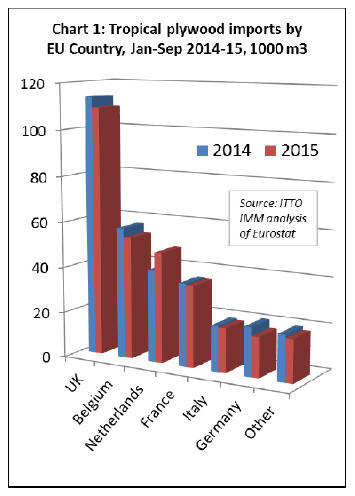
Imports of tropical plywood into the UK were
109,093cu.m in the first nine months of 2015, 4% less than
the same period in 2014.
Imports also declined into Belgium (-6.7% to
53,569cu.m), France (-1.7% to 35,746 cu.m), Italy (-2.6%
to 19,384cu.m) and Germany (-17.2% to 17,705cu.m)
during this period (Chart 1).
Of the six main tropical plywood consuming countries in
Europe, only the Netherlands increased imports during the
first nine months of 2015, by 20% to 48,471cu.m.
This aligns with the trend in imports of other tropical
wood products into the Netherlands, including sawn wood,
joinery and flooring, all of which have increased
significantly in 2015.
After several years of decline, the Netherlands market for
tropical wood has bottomed out and appears to be on the
way to sustained recovery.
EU plywood imports from Malaysia fall 10%
Much of the decline in EU imports of tropical plywood
during the first nine months of 2015 was due to lower
deliveries from Malaysia, which fell 10% to 78,148cu.m.
Tropical plywood imports from Indonesia, at 82,053
cu.m,, were close to the level of the previous year (Chart
2).
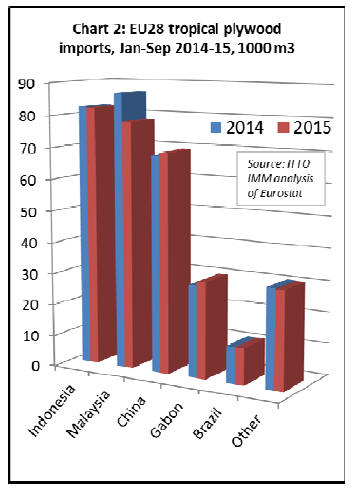
Indonesia¡¯s comparatively good performance is mainly
due to recovery in the Netherlands and increasing sales in
the UK. However Indonesian plywood has been losing
market share in Germany this year, both to alternative
European and Russian plywood and to wood plastic
composites.
Of the three remaining large suppliers of tropical plywood
to the EU, imports in the first nine months of 2015
increased from China (+1,9% to 69,346cu.m) and Gabon
(+4.8% to 30,627cu.m) and remained stable from Brazil
(at 11.646cu.m).
France and Italy increase tropical veneer imports
EU imports of tropical veneers increased 8.8% to
311,372cu.m in the first nine months of this year, mainly
due to recovery in the traditional markets in France and
Italy which together account for almost half of the EU¡¯s
tropical veneer imports.
Imports increased into France by 16.4% to 86,915cu.m
and Italy by 15.9% to 47,725cu.m. There were also gains
in imports by Romania (+64.8% to 13,073cu.m) and
Greece (+32.9% to 12,235cu.m).
However there was a sharp decline in imports into Spain (-
12.9% to 26,166cu.m) and Germany (-26.2% to
9,659cu.m) during the same period (Chart 3).
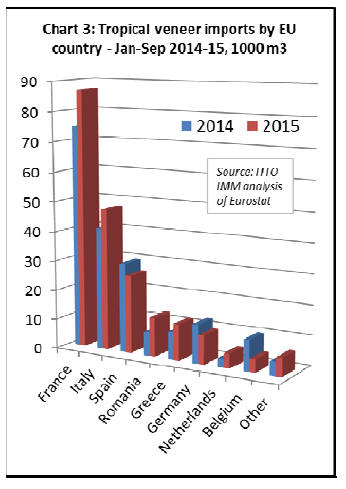
Much of the increase in EU imports of tropical veneer
during the first nine months of 2015 was due to a sharp
rise in deliveries from Gabon (+19.2% to 104,987cu.m)
(Chart 4).
French and Italian okoum¨¦ plywood producers, sourcing
veneer primarily from Gabon, have benefitted from
improved demand this year.
Demand has recovered in the Netherlands, while some
improvement is also reported in both the French and
Italian domestic markets.
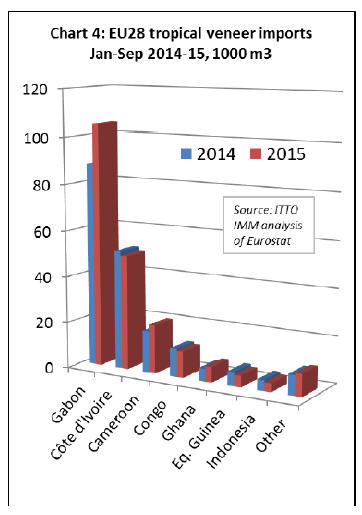
Besides Gabon, Cameroon (+16.3% to 20,866cu.m) and
Ghana (+21.1% to 6,600cu.m) also stepped up deliveries
of tropical veneer to Europe during the first nine months
of 2015.
However, imports from all other major supply countries
declined this year, including from Ivory Coast (-3.6% to
49,469cu.m), Congo (-7.0% to 11,249cu.m), Equatorial
Guinea (-17.3% to 4,953cu.m) and Indonesia (-21% to
3.673cu.m).
Tropical wood flooring imports shift from Belgium to
France
Total EU imports of wood flooring from tropical countries
were practically unchanged (+1% to 3.327 million sq.m)
in the first nine months of 2015. However import trends
varied widely between European countries.
Most notably imports into France increased 32.9% to
760,784 sq..m, a gain offset by a 38.3% decline to 407,264
sq.m in imports by Belgium (Chart 5).
These trends are more likely due to alterations in
distribution networks for wood flooring in north-western
Europe than to any significant change in consumption
levels.
The European Federation of the Parquet Industry (FEP)
reports that wood flooring sales in France were merely
stable in the first nine months of this year; an increase in
sales by around 3% in the first few months was followed
by a satisfactory second and a weaker third quarter.
FEP also reports stable sales and consumption of wood
flooring in Belgium in the first nine months of this year.
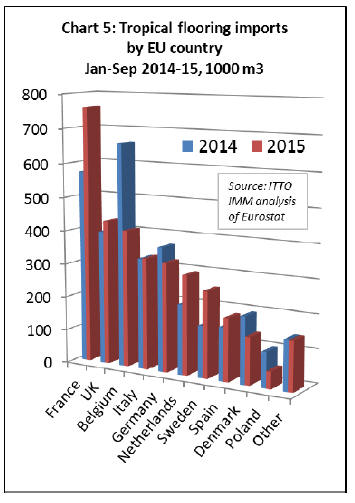
UK imports of wood flooring from tropical countries
increased 8.2% to 430,659 sq.m in the first nine months of
2015. This aligns with FEP estimates that overall wood
flooring sales in the UK increased by around 5% in the
first nine months of this year.
Italian imports of wood flooring from tropical countries
were stable at 330,829 sq.m in the first nine months of
2015, also in line with FEP estimates of stable overall
wood flooring consumption in Italy.
Imports of wood flooring from tropical countries into
Germany declined 12.2% to 323,661 sq.m in the first nine
months of 2015. FEP reports that luxury vinyl tiles (LVT)
remain a strong competitor to wood flooring assortments
in this market.
However, the total market for wood flooring in Germany
appears to be performing better than the tropical wood
segment. FEP records stable sales of all wood flooring in
Germany in the first nine months of 2015. The German
market continues to see a strong trend of using oak in both
flooring and furniture.
In the Netherlands, recovery in the building sector is
reflected in a 42.6% increase in imports (to 295,344 sq.m)
of wood flooring from tropical countries in the first nine
months of 2015.
Unlike Germany, imports of wood flooring in the
Netherlands from tropical countries increased more
rapidly than overall demand. FEP records no more than a
2% increase in overall wood flooring sales in the
Netherlands during the period.
However FEP confirms that the Dutch housing market has
¡°a better outlook than in the last seven years¡±.
Sweden (+66.4% to 255,746 sq.m) and Spain (+18.5% to
186,178m2) also registered significant increases in wood
flooring imports from tropical countries in the first nine
months of 2015, although from a very small base.
In contrast, imports declined sharply into Denmark (-
29.1% to 139,810 sq.m) and Poland (-51.5% to 50,486
sq.m), despite FEP reporting a slightly positive
development in overall wood flooring sales in both
countries during the same period.
Indonesia, the largest supplier of wood flooring into
the EU
Indonesia is currently the single largest tropical supplier of
wood flooring into the EU market. EU imports from
Indonesia increased 7.6% to 1.144 million sq.m in the first
nine months of 2015. Imports also increased from Viet
Nam (+22.4% to 315,903 sq.m) and Brazil (+3.7% to
526,114 sq.m) during the same period.
However imports fell from Malaysia (-7.0% to 963,560
sq.m), Thailand (-4.1% to 80,609 sq.m), Peru (-29.9% to
66,562 sq.m) and China (-2.3% to 53,497 sq.m) (Chart 6).
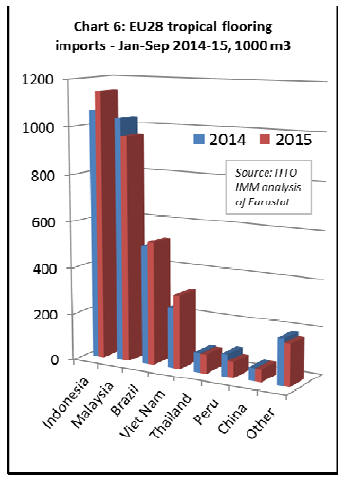
|